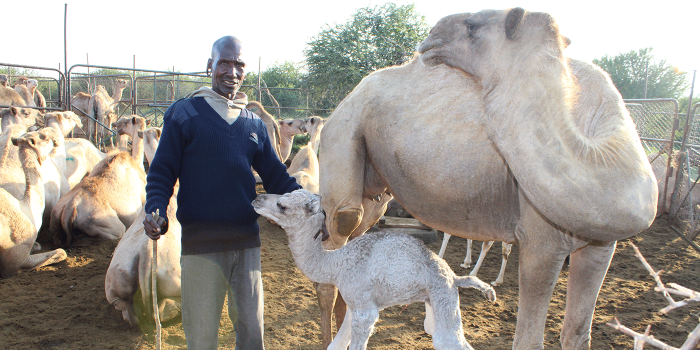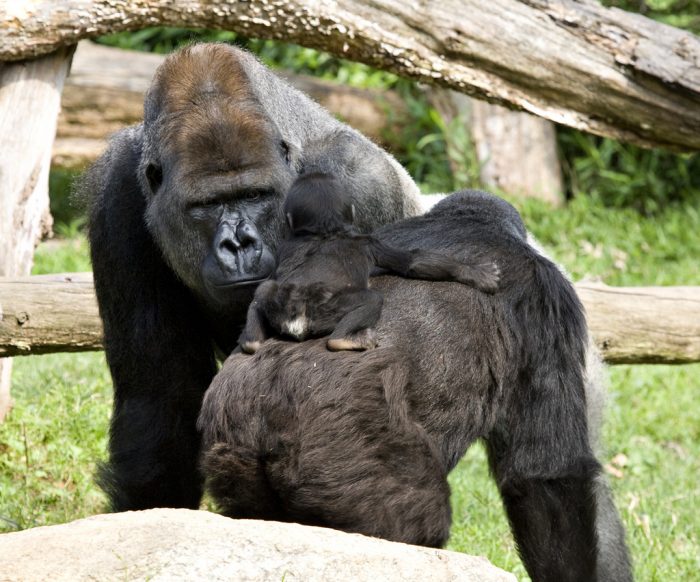A planet in peril
We are only beginning to understand the interwoven complexity of life on Earth. The unraveling of a single thread—the extinction of a species, the emergence of a pandemic—can have a devastating effect. Dr. Skorton spoke with Dr. Suzan Murray about the Smithsonian Global Health Program and its work to keep Earth’s rich tapestry intact.

Black Rhinos in Ngorongoro Crater, Tanzania. The image is a scan of an old film print photograped by Brocken Inaglory (CC BY-SA 3.0)
With roughly 5,500 individuals remaining in the wild, the Black Rhino population is critically endangered. To help save these iconic African giants, at risk for several reasons, the Smithsonian Global Health Program is working with partner organizations in Kenya to help stabilize the population. This is just one of its current initiatives: others focus on research, including the study of zoonotic diseases, and on sharing our knowledge with professionals elsewhere in the world. I recently spoke with Dr. Suzan Murray of the Smithsonian’s National Zoo and Conservation Biology Institute, who directs the Global Health Program.
How does the Global Health Program support the Smithsonian’s mission?
Suzan Murray: The program has three pillars – Wildlife Health, Research and Training – and, together, they represent how we share our expertise and resources in wildlife health and disease, including zoonotic and emerging infectious diseases, to contribute to the greater good. We use the resources we have in collaborative ways, with other organizations. A major tenet of our program is the training of professionals here and in other countries.
Why is research into zoonotic diseases so important to the program?
Six out of ten infectious diseases in humans are spread from animals so research into zoonotic diseases—diseases spread between species—is fundamental to our work. We consider ourselves stewards of the “One Health” concept, which recognizes the connection between human and animal health and the environment. Through the “One Health” program, the Centers for Disease Control encourages collaborative efforts involving multiple disciplines at the local, national and international level, and we support all of these. Preventing the next pandemic hinges on connections between animal and human medicine. We are helping to save human lives, by supporting veterinary capacity, especially in areas with limited resources.

In Kenya, the Smithsonian Institution maintains a close collaboration with the Mpala Research Center and Ranch located in Laikipia County. The camel herd at Mpala recently tested positive for the Middle-East Respiratory Syndrome Coronavirus (MERS CoV). The disease is concerning because it has the potential to cause a serious, sometimes fatal respiratory disease in humans. Kenya has the third-highest population of camels in Africa and their numbers are growing rapidly in Laikipia County. To address this potential public health threat, Smithsonian Global Health sent Dr. Devin Tunseth, a wildlife veterinarian and McCarters’ Global Health Intern, to sample camels and mosquitoes at MRC as a part of a pilot study for future research in the area. In the photograph, a local herder welcomes a newborn camel calf, which he named “Devin” in honor of Dr. Tunseth. (Photo courtesy SGH)
What are some of the major international projects you’re supporting?
We are a founding partner of the USAID Emerging Pandemic Threats Program: PREDICT, which conducts global surveillance to detect and prevent spillover of pathogens of pandemic potential. We are supporting PREDICT-2 projects in Myanmar and Kenya. We’ve made significant progress in Myanmar by establishing partnerships with two government laboratories and through field training and wildlife sample collection. One of our Myanmar projects focuses on the pangolin, endangered as the most trafficked mammal in the world. In Kenya, we are working with partners to help achieve Global Health Security Agenda milestones, including disease surveillance, building One Health capacity, coordinating emergency operations, strengthening labs, and implementing biosafety and biosecurity training. Through our work in Kenya, we interact with people in communities, and have a hand in developing conservation efforts by helping populations save species. Working with young women there is very rewarding. This year, we welcomed our first international research fellow, Dr. Mathew Mutinda, a veterinarian with the Kenya Wildlife Service. He and other SGH team members are researching baboons, lions and rhinos.

Smithsonian Global Health, through the U.S. Agency for International Development PREDICT program, aims to strengthen developing countries’ ability to detect, control and prevent infectious diseases. SGH collaborates with local Myanmar organizations to provide education, training and resources to aid in the identification and prevention of zoonotic diseases. Throughout the country, scientists from SGH, PREDICT, local universities, and food and agriculture organizations collect samples from a wide array of wild and domestic species including primates, bats and rodents in areas where there is increasing human-animal contact. (Photo courtesy SGH)
I understand cardiovascular disease is the primary cause of death in captive gorillas. As a cardiologist, I am interested in any possible connections to human heart health.
I focused on cardiology in my veterinary studies so this research is fascinating to me. We are learning that there are similarities and differences. In humans, heart disease is more coronary in nature, involving blood vessels around the heart. In apes, the problem is “fibrosing cardiomyopathy” or the replacement of heart muscle by fibrous tissue. We discovered this difference when we lost two gorillas at the Zoo. As part of our research, we successfully employed a diagnostic test that is used for humans and we are now treating gorillas with medication that is very similar to what we give humans. This research was accomplished by a team of veterinarians and physicians, all of whom volunteered their time. Through the Global Health program, we are able to improve the care and survival of animals in the wild because of the research we conduct on animals in captivity.

Western lowland gorilla Baraka interacts with infant Kibibi and her mother Mandara at the National Zoo in 2009. Baraka is the leader of Zoo’s family group of gorillas. (Photo by Mehgan Murphy)
With just 22 member organizations, how does the Global Health Program manage to accomplish all it does, all over the world?
We’ve only been up and running two years and growth has been dramatic, but it’s not nearly enough to do everything we would like to do as far as providing veterinary help and capacity-building in all of the countries the Smithsonian has a presence in, which is our goal. We have so many great partners and work with so many talented and gifted people.
Your projects span a wide range of animal populations, from pangolins to pandas to camels to bats—how do you recruit and prepare professionals for working in such a broad range of situations and environments?
We are trying to hire people with a broad range of training in different species. In human medicine, people expand and build their knowledge and expertise through internships and residencies. In veterinary medicine, internships and residencies focus on different species. One of the country’s longest veterinary programs is our own, at the National Zoo. We have been able to hire interns and fellows through the generosity of donors, which is enabling the program to accomplish a great deal, in many locations. We provide extensive training in many areas, from human subject research to personal safety to security awareness and we emphasize the importance of protective equipment and procedures.
What is the most rewarding aspect of your work?
To be able to contribute to the health and wellbeing of animals and humans. I never expected to have such a rewarding career–who gets to go to work and know you are helping to save an endangered species as well as human beings?

Suzan Murray (left) with three generations of women in Myanmar. Women and the communities they foster are an important driver of the decisions upon which conservation depends. (Photo courtesy of Suzan Murray)
Posted: 4 November 2016



